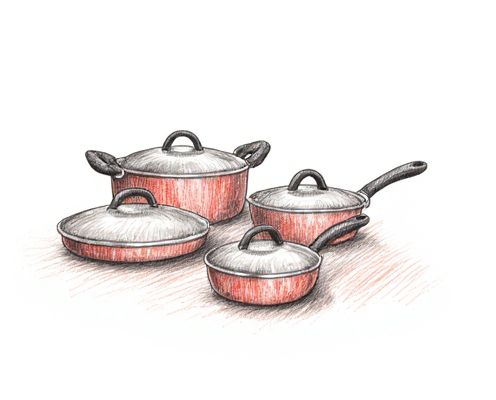
Ceramic cookware Illustration
Ceramic cookware offers a non-toxic, eco-friendly alternative to traditional pots and pans, providing excellent heat retention and even cooking results. Its non-stick surface facilitates easy food release and simple cleanup, making it ideal for everyday use. Resistant to scratches and thermal shock, ceramic cookware combines durability with aesthetic appeal, enhancing any kitchen environment.
Why Women Prefer Ceramic Cookware in Modern Kitchens
Women prefer ceramic cookware in modern kitchens due to its non-toxic, chemical-free composition that ensures healthier meal preparation. The superior heat distribution and easy cleanup of ceramic pots and pans enhance cooking efficiency and convenience. Its sleek, aesthetically pleasing design complements contemporary kitchen decor, making ceramic cookware a favored choice among female home chefs.
Key Benefits of Using Ceramic Cookware
Ceramic cookware offers exceptional heat retention and even heat distribution, resulting in consistent cooking performance. It is naturally non-stick and free from harmful chemicals like PTFE and PFOA, promoting healthier meal preparation. The durable and scratch-resistant surface of ceramic cookware ensures long-lasting use while maintaining its aesthetic appeal.
Health and Safety Features of Ceramic Cookware
Ceramic cookware is prized for its non-toxic, chemical-free composition, ensuring no harmful substances like PTFE or PFOA leach into food during cooking. Its natural non-stick surface reduces the need for excessive oils, promoting healthier meal preparation. Additionally, ceramic cookware distributes heat evenly, minimizing hot spots that can cause food burning and potential formation of harmful compounds.
Non-Toxic Cooking: The Allure of Ceramic Pots and Pans
Ceramic cookware offers a non-toxic alternative to traditional metal pots and pans, eliminating risks of harmful chemical leaching often found in non-stick coatings like PTFE and PFOA. The natural composition of ceramic ensures safe, toxin-free cooking, preserving food flavor and nutritional value without exposing meals to synthetic substances. Durable and heat-resistant, ceramic pots and pans maintain even heat distribution while supporting eco-friendly, health-conscious kitchen environments.
How Ceramic Cookware Enhances Cooking Experience for Women
Ceramic cookware offers non-toxic, PTFE- and PFOA-free surfaces that ensure healthier meal preparation, making it especially appealing to women prioritizing family nutrition. Its excellent heat distribution and retention provide even cooking results, reducing the likelihood of burnt or undercooked food and saving time in the kitchen. Lightweight and easy to clean, ceramic cookware enhances convenience and comfort, allowing women to focus more on creativity and enjoyment during meal preparation.
Tips for Choosing the Best Ceramic Cookware Set
When selecting the best ceramic cookware set, look for high-quality, non-toxic ceramic coating that ensures even heat distribution and durability. Choose sets with scratch-resistant surfaces and ergonomic handles to enhance cooking comfort and longevity. Your investment in well-crafted ceramic cookware results in healthier meals and an easier cooking experience.
Step-by-Step Guide to Caring for Ceramic Kitchenware
To maintain the durability and non-stick qualities of your ceramic cookware, always hand wash with a soft sponge and mild detergent, avoiding abrasive cleaners that can damage the surface. Allow ceramic pots and pans to cool completely before cleaning to prevent cracking caused by temperature shock. You can extend the lifespan of your ceramic kitchenware by seasoning it occasionally with a small amount of oil to preserve its non-stick coating.
Comparing Ceramic Cookware to Other Popular Options
Ceramic cookware offers non-toxic, eco-friendly benefits with excellent heat retention and even cooking compared to traditional non-stick pans that may contain harmful chemicals like PFOA or PTFE. Unlike stainless steel, ceramic pots and pans provide a naturally non-stick surface without the need for oils, making them easier to clean and healthier for low-fat cooking. However, ceramic cookware can be less durable and more prone to chipping than cast iron or stainless steel, requiring careful handling to maintain its longevity.
Common Mistakes to Avoid with Ceramic Cookware
Avoid overheating ceramic cookware to prevent cracking and damage to the non-stick surface, as extreme heat can degrade the coating. Using metal utensils can cause scratches, compromising the cookware's durability and performance, so always opt for wooden or silicone tools. Neglecting to hand wash ceramic pots and pans may reduce their lifespan, making gentle cleaning with mild detergent essential to maintain their non-stick properties.
Frequently Asked Questions about Ceramic Cookware Safety
Ceramic cookware is often praised for being free of harmful chemicals like PFOA, PTFE, and lead, making it a safe option for cooking. It provides excellent heat retention without releasing toxic fumes at high temperatures, unlike some non-stick pans. Proper care, such as avoiding metal utensils and abrupt temperature changes, ensures the ceramic coating remains intact and maintains its safety features.
 womendy.com
womendy.com